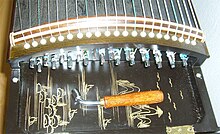
Back Yatga German Yatga French ヤトガ Japanese 야특 Korean Ятга Mongolian Yatga Dutch Jatag Polish Ятга Russian Yatga Uzbek
 Mongolian yatga | |
| String instrument | |
|---|---|
| Other names | Nothђьь |
| Classification | |
| Developed | Antiquity |
| Related instruments | |
The yatga (Mongolian: ᠶᠠᠲᠤᠭᠠ, romanized: yatug-a, Khalkha dialect: ятга, yatga; pronounced [ˈjɑtʰəq]; is a traditional plucked zither of Mongolia.

Yatga may vary widely in size, tuning, and number of bridges and strings; The body is a long wooden box, one end of which is angled downward. The performer plucks the strings with the fingernails of the right hand; the left hand is used to put pressure on the strings, varying the note. The left hand can also be used to play the bass strings without plectrums (picks). Depending on style the higher strings are picked by fingers or by picks.
Similar instruments include the Chinese se and yazheng, Korean gayageum and ajaeng, the Vietnamese đàn tranh, the Japanese koto,[1] the Kazakh jetigen, and the Sundanese kacapi.
The most common type of yatga in contemporary use is the twenty one-stringed version. This type of yatga is also called a "master yatga." The length of a full-size instrument is 1.62m or 63 inches. Shorter versions are pitched higher. A 13-stringed version is called gariin yatga, "hand yatga".
The strings are made either from silk, horse hair or goose gut.[2]
Usually the strings are tuned pentatonic. The most common tune is C D E G A (Do Re Mi So La) or different tunes.
- ^ Description from the Silk Road Ensemble Archived November 17, 2007, at the Wayback Machine
- ^ FeltNation -> About Mongolia -> Culture -> Music